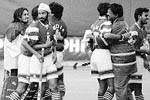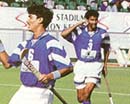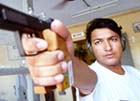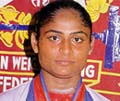|
December 30, 1997
NEWS
MATCH REPORTS
STAT SHEET
OTHER SPORTS
SLIDE SHOW
PEOPLE
DEAR REDIFF
|
The year in Indian sport
Prem Panicker
I remember reading somewhere that an earthworm has about 100-odd brain cells. With which, it is able to make itself a home, feed itself, ward off its enemies, and generally live (early birds and fishermen notwithstanding) to a ripe old age. Question there was, how come man, with several million brain cells, doesn't manage to do more?
A similar thought is inevitable when you sit down, at year end, to review the performance of India in sports. You number on your fingers the achievements of Indian sportsmen and sportswomen, and you wonder -- shouldn't there be more, for a country of 950 million plus?
Another thing that strikes you forcibly is that almost all the achievements come from individual effort. And that, in turn, brings up the question -- what, then, is the purpose of having a sports ministry with a multi-million budget?
Not new questions, these. Sadly, the year just ending failed, as its predecessors did, to throw up any answers. Worse, the usual year-ending feeling of yeasty optimism that the coming year will be better is sadly missing from the sporting scenario.
So what exactly did India achieve on the international stage? We take it a sport at a time, starting with...
HOCKEY
 Indian hockey, for once in a long time, held out prospects of a better tomorrow. Mainly because the real performers were the young lads -- vide the Under-21 team's performance in the Junior World Cup at Milton Keynes where, in September this year, the side had a dream run into the final.
Indian hockey, for once in a long time, held out prospects of a better tomorrow. Mainly because the real performers were the young lads -- vide the Under-21 team's performance in the Junior World Cup at Milton Keynes where, in September this year, the side had a dream run into the final.
That was India's best ever performance at the junior world. It was also India's first ever appearance since 1985, when the event was held in Vancouver.
What was interesting about the performance was that for once, a sports body -- in this instance, the Indian Hockey Federation -- showed foresight and planning ahead of a major sports event. The norm is for the concerned body to wake up a fortnight before the big one, to pick a team with little relevance to current form and performance, to conduct a rather farcical "preparation camp" and, even before the team takes off for the tournament, to begin preparing the groundwork for excuses and explanations for the inevitable defeat.
This time round, the IHF got everything right, the emphasis being laid, rightly, on making the squad get as much match play as possible ahead of the big one. The MCC-Murugappa tournament in Madras, the series against England, then a tough one against Germany, then the Junior Challenge Cup in Poznan which the team in fact went on to win, and the auguries were good.
 Equally importantly, coach Vasudevan Bhaskaran revealed a good thinking head, eschewing needless chopping and changing of personnel, concentrating instead on building a solid team and letting it settle down into a group of 11 players each of whom knew their roles in the overall scheme of things.
Equally importantly, coach Vasudevan Bhaskaran revealed a good thinking head, eschewing needless chopping and changing of personnel, concentrating instead on building a solid team and letting it settle down into a group of 11 players each of whom knew their roles in the overall scheme of things.
That there is nothing to compare with preparation showed in th smooth progress of the squad, after an initial defeat to Spain. A remarkable recovery against Australia, then a fine win over the strong Netherlands team and an even more impressive semifinal outing against defending champs Germany before the defeat in the final (thanks, in part at least, to some dubious umpiring) and for once, an Indian hockey team has played to par and beyond, not just in one game but through a tough, demanding tournament.
The tournament threw up some rather remarkable talents -- most especially the irreprissible Rajiv Mishra (in whom, for once, India appears to have found a forward who knows that the area within the circle is for scoring goals in, not for rhythmic gymnastics with hockey stick) and the calm, steady Dilip Tirkey and skipper Baljit Singh Saini providing the backbone.
Coach Bhaskaran got it right when he said that a bulk of this side will be playing for the senior team (Saini and Tirkey are already full-fledged Olympians) within the next twelve months -- and that can only be to the good.
The senior side had an eminently forgettable 1997. But their real test is in 1998, when, beginning January, the squad under coach Pargat Singh plays four Tests against Germany followed by eight matches against Pakistan. It will be interesting to see just what kind of team is shaped by the IHF, given the wealth of young talent available in the country today.
And in passing -- in fact, it is a pity that the distaff side only gets an in-passing mention, when you think of it -- the women's team did well to qualify for the World Cup, for the first time in the last 12 years, with a fourth place finish in the qualifying tournament.
TENNIS
 Talk of Indian tennis in the year 1997, and you enter -- a rare occurence, admittedly -- the feelgood zone.
Talk of Indian tennis in the year 1997, and you enter -- a rare occurence, admittedly -- the feelgood zone.
It is both heartening, and rather sad, really. Heartening, to see two young Indian boys make a successful surge for top honours at the world level. Sad, to realise that they did it despite, not because of, the system.
Why is that factor important? Simply because if Leander Paes and Mahesh Bhupati had been part of any systematic training and coaching effort under the aegis of the Indian sports establishment, then there would be the hope that this success would be repeated by others, that the system would produce more winners.
Here, however, the two young stars did it on their own. Scrambled their way through the ATP circuit for three, four years, ekeing out a modest income, paying their own way, finding the funds and sponsorship they needed on their own, organising their own coaching, and finally reaping the reward for perseverance.
And that I guess is what makes the Paes-Bhupati combine's record even more outstanding. Six ATP doubles titles, three Challengers and a second place in the World Doubles Championships -- easily the best run by any doubles pairing in the world this year.
The run actually began earlier, when Mahesh Bhupati teamed up with Rika Hiraki of Japan to win the mixed doubles crown at the French Open -- a first by an Indian.
Paes and Bhupati then teamed up at the ATP Challenger in Madras to win their maiden title. Six months later, they had added titles at Prague, Montreal, Beijing, New Haven, and Singapore, and a runners-up at the prestigious year-ending world doubles tournament at Hartford, Connecticut.
In the process, the duo upped their rankings 32 places, to number four in the world -- another first, this being the first time an Indian pairing finished a year in the world top ten.
The two, who combined perfectly on the doubles court -- their chest butting, fist-pumping style of approach, characterised by flat out aggression, winning them fans across the world -- appeared a shade less at home in the singles. Paes did make two ATP tour semifinals, and broke the top 100 when he finished the year ranked number 98, while Bhupati's best was when he qualified for three ATP tour tourneys and, in the process, produced a fighting performance against former world number one Jim Courier in Los Angeles.
Mahesh also cracked the individual top ten rankings in doubles when, teaming with Rick Leach, he beat the Patrick Rafter-Mark Phillippoussis pairing at the Infiniti Open in Los Angeles. That upped his individual rankings to number 9 and a year later, his partner Paes joined him in the top ten, coming in at number ten.
As always, the Indians had a giant-killing year in Davis Cup play, beginning the year with a fighting 2-3 defeat at the hands of a Czech side led by Petr Korda, and ending it with a superb 3-2 win against a talented Chile outfit led by top tenner Marcelo Rios.
CHESS
 At the time of writing this, Vishwanathan Anand is poised to take top slot in the FIDE World Championship title round, which means he will challenge Anatoly Karpov for the world title. Meanwhile, in a rare tribute to Anand's chess skills, Players' Chess Association champion Garri Kasparov, rated by many the best player of the century, has indicated that he would like a second go-round against Anand for the title, dismissing in the process the claims of Karpov for the honour by indicating that in his, Kasparov's, opinion, Anand is the best player in the world after himself.
At the time of writing this, Vishwanathan Anand is poised to take top slot in the FIDE World Championship title round, which means he will challenge Anatoly Karpov for the world title. Meanwhile, in a rare tribute to Anand's chess skills, Players' Chess Association champion Garri Kasparov, rated by many the best player of the century, has indicated that he would like a second go-round against Anand for the title, dismissing in the process the claims of Karpov for the honour by indicating that in his, Kasparov's, opinion, Anand is the best player in the world after himself.
Easily India's most consistent achiever over time, Anand began the year with a second place at Las Palmas behind Kasparov, then slumped to a rare sixth at Linares before taking top spot at the Dos Hermanas tournament in April. He then took on the megabyte world of chess computers, playing six and winning handily in an exhibition at the Hague. First place results at Amber Rapids in Monaco and Frankfurt, a second behind Vladimir Kramnik in Dortmund, first again in Biel and a shared first in Belgrade formed the run up to his outing in the ongoing FIDE title round of the world championships.
Meanwhile, Pravin Thipsay finally made Grandmaster -- completing a process he began way back in 1984 when he achieved his first norm.
A sixth place finish in the Under-16 World championships by Mahesh Chandran, two fine wins by young Indian challengers in the world Under-10 age category tournaments in Britain and a continuation of his promising run by P Harikrishna, winning of the world U-10 title in 1996, made for a healthy scenario in Indian chess. And the remarkable rise of Abhijit Kunte, India's new national champion and winnner, at a very young age, of the national title besides the Asian Junior title (which brought him his first grandmaster norm) indicate that with good backing, India could have found the successor to Anand.
OTHER SPORTS
 Indian badminton had its most traumatic year ever, with gross mismanagement by the official body forcing former all-England champion Prakash Padukone, now heading the BPL badminton coaching centre in Bangalore, to launch a rival body that had the support of all leading players.
Indian badminton had its most traumatic year ever, with gross mismanagement by the official body forcing former all-England champion Prakash Padukone, now heading the BPL badminton coaching centre in Bangalore, to launch a rival body that had the support of all leading players.
For a while, it looked like the rival body would actually end up wiping out the official one -- but the last minute intervention of the international badminton association in the person of Punch Gunalan brought about a patch up, and an executive post for Padukone in the official body with charge of tournaments and talent development.
A case of all's well that ends well, really, and K Gopichand, one of Prakash's wards at the BPL academy, climbed into the top 30 rankings in the world, in the process scalping former Olympics champion Alan Budi Kusuma at the all England. Gopichand's suspect knee, in fact, was all that stood between him and a much higher spot in the world rankings table, and with BPL sponsoring his treatment, indications are good that 1998, for this talented shuttler, could bring even higher laurels.
Golf, meanwhile, took off on Indian courses. And the game got a further fillip when Gaurav Ghei hit the headlines by becoming the first Indian to qualfy for the British Open, while Chranjeev Milkha Singh climbed to number three in the Omega Asian Order of Merit charts.
 Jaspal Rana, whose disappointing outing in the Los Angeles Olympics is the stuff of recent memory, continued his climb back into global reckoning, equalling the world record in the standard pistol event in the South Asian championship, besides bringing back team golds in rapid fire pistol and air pistol and a silver in the team centre-fire pistol events at the Commonwealth championships. At the same event, he also equalled the Asian record in centre fire pistol while picking up an individual gold, to add to his silver in the air pistol event. Another Indian marksman, Satender Kumar, took gold in the free pistol event, then teamed with Vivek Singh to bring home the team gold as well.
Jaspal Rana, whose disappointing outing in the Los Angeles Olympics is the stuff of recent memory, continued his climb back into global reckoning, equalling the world record in the standard pistol event in the South Asian championship, besides bringing back team golds in rapid fire pistol and air pistol and a silver in the team centre-fire pistol events at the Commonwealth championships. At the same event, he also equalled the Asian record in centre fire pistol while picking up an individual gold, to add to his silver in the air pistol event. Another Indian marksman, Satender Kumar, took gold in the free pistol event, then teamed with Vivek Singh to bring home the team gold as well.
Individual achievements on the green baize continued, with Ashok Shandilya finishing number two in the world amateur billiards championships, while leading pro Geet Sethi continued his win-some, lose-some run through the year.
 More individual achievements, this time on the distaff side, came when Karnam Malleshwari swept everything before her at the Asian weighlifting championships in China where she, along with the likes of Kunjurani Devi and Sumita Laha, held her own against the very powerful Chinese contingent. In the process, Malleshwari and Devi raised hopes, however tenuous, of medals at the Sydney Olympics.
More individual achievements, this time on the distaff side, came when Karnam Malleshwari swept everything before her at the Asian weighlifting championships in China where she, along with the likes of Kunjurani Devi and Sumita Laha, held her own against the very powerful Chinese contingent. In the process, Malleshwari and Devi raised hopes, however tenuous, of medals at the Sydney Olympics.
At the end of the year, when you sit back to examine the canvas of Indian sport over the past 365 days, sifting through the dross for the odd sparkle of gold, one conclusion is inescapable -- if you want to achieve anything of note in India, you have to do it on your own; in the process turning a very deaf ear to the grandiose pronouncements that are all that the Federal sports ministry has to show for its very expensive existence.
Tomorrow: The year in cricket, a comprehensive review
Prem Panicker
|